
by Terri Cook Thursday, April 21, 2016
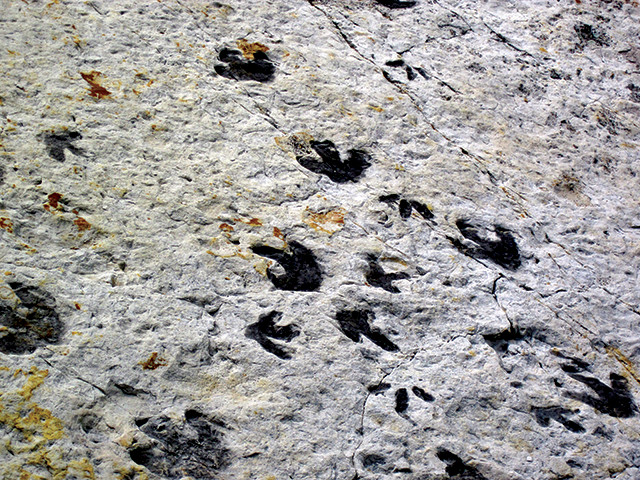
The first set of dinosaur trackways in the Denver area was discovered at Dinosaur Ridge in the 1930s. Two types are preserved on the pictured slab: a birdlike, three-toed print belonging to an ostrich-sized carnivore like Ornithomimus, and a more bulbous print made by an herbivorous duck-billed dinosaur such as an Iguanodon. Credit: James St. John, Ohio State University, Newark.
Since 1877, when Arthur Lakes, a professor at the Colorado School of Mines, spotted an enormous vertebra embedded in a block of sandstone on a rocky ridge near Golden, Colo., the Denver region has played a pivotal role in expanding scientific knowledge of dinosaurs. Skeletons of many of the most familiar species, including Stegosaurus, Allosaurus and Apatosaurus, were first discovered in the area, and a stunning set of dinosaur tracks was unearthed on the same ridge during road construction in the 1930s. Studies of these and other tracks since the 1980s have kept the area at the forefront of dinosaur research, while conservation efforts have protected many irreplaceable sites from ever-expanding suburbs.
This rich paleontological legacy makes Denver one of the best places in North America, and perhaps the world, to learn about dinosaurs. You can see a tremendous number of dinosaur bones and trackways in a day or two of exploration around Denver and its suburbs. So if you’re planning a trip to Colorado to ski, hike or sightsee, or if you’re interested in a full-on dinosaur extravaganza, perhaps including a visit to the “Dinosaur Diamond”, put Denver’s dinos on your must-do list.
In 1877, Lakes’ startling discovery immediately grabbed the attention of two preeminent paleontologists, Edward Cope, a comparative anatomist at the Academy of Natural Sciences in Philadelphia, and Othniel Marsh, the first professor of paleontology at Yale University. The two became bitter competitors in a frenetic, continentwide search for fossils. The paleontologists bore each other such ill will that they spied on one another’s digs, stole each other’s fossils, and actively sabotaged each other’s reputations. The acrimonious rivalry, known as the Bone Wars, reached such intensity that Marsh blasted one of his own quarries to prevent Cope from excavating it, and Cope, upon his death, bequeathed his skull to science with the expectation that, once measured, his (presumably) larger brain size would conclusively prove his intelligence was superior to Marsh’s.
Because the bones that Lakes had discovered were the largest ever found, the two rivals instantly shifted their focus to the Denver area. This was the first time that fossilized bones had been discovered in the Morrison Formation, a Jurassic-aged unit named for the nearby town of Morrison, Colo., where Lakes, who decided to work with Marsh, eventually supervised excavations in 13 separate quarries. This unit has since become the continent’s most abundant source of dinosaur fossils.
Bones in the 150-million-year-old Morrison Formation are concentrated in lenses of sandstone surrounded by soft red, green and purple mudstones — deposits characteristic of meandering rivers whose ancient channels were filled with sand and on whose floodplains the rivers’ spreading waters dumped large quantities of fine-grained mud. This series of rivers drained an ancient mountain range to the west, carrying sediment east to the area that now includes Denver and depositing it in a series of swampy lowlands reminiscent of today’s Mississippi River Valley.
The rocks of the Morrison Formation are overlain by the Cretaceous-aged Dakota Group, another package of sandstone and mudstone rock units. However, the lack of sandstone lenses, the prevalence of ripple marks, and the uniformly dark gray color of these younger mudstones indicate that by 105 million years ago, Denver’s setting had changed completely. Rising global seas had flooded the low-lying coastal plain east of today’s Rockies, creating a shallow ocean called the Western Interior Seaway. At that time, Denver lay along the western shore of this seaway, which stretched from New Mexico to Wyoming (at its greatest extent, about 90 million years ago, it reached from the Gulf of Mexico all the way to the Arctic Ocean), such that the Dakota Group, unlike the Morrison Formation, was deposited in a coastal setting.
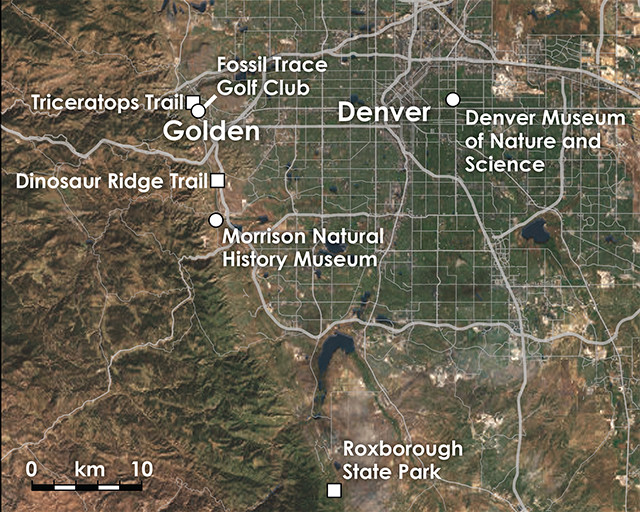
In just a day or two, visitors to the Denver area can see numerous dinosaur bones and trackways. Credit: K. Cantner, AGI.
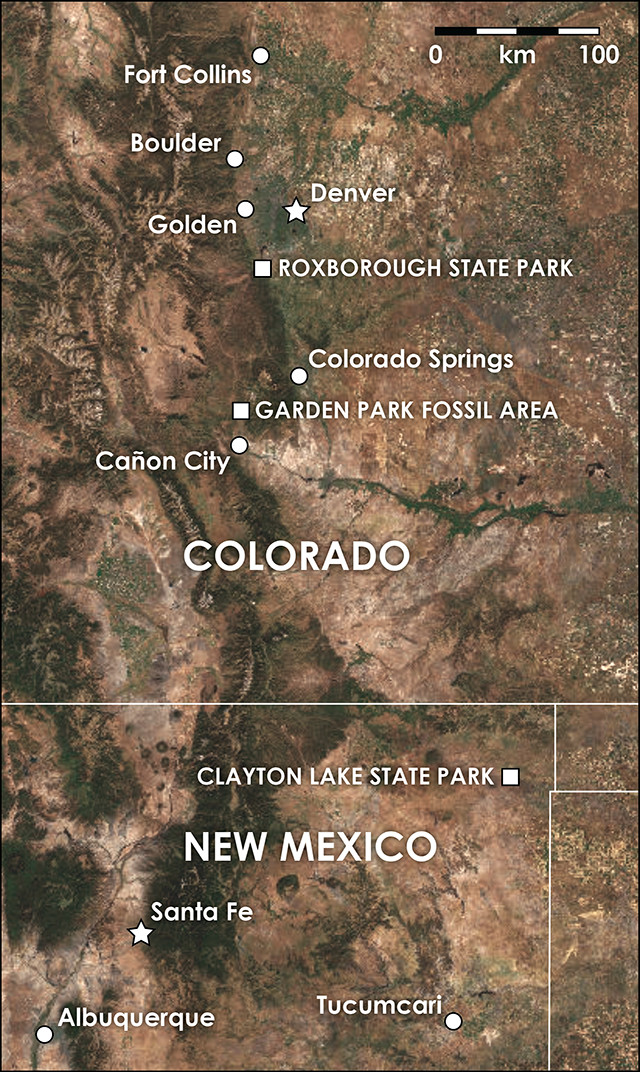
The "Dinosaur Freeway" stretching from Boulder, Colo., to Tucumcari, N.M. Credit: K. Cantner, AGI.
Begin your explorations at Dinosaur Ridge, the site of Lakes’ original discovery in the foothills west of Denver. Uplift of the Rocky Mountains about 65 million years ago tilted the stack of sedimentary layers here up to the west. So it’s possible to see both the Dakota Group and the Morrison Formation — as well as their very different fossil treasures, including recently discovered evidence of dinosaur courtship — in a short 4-kilometer round-trip walk that’s punctuated with helpful interpretive signs. (A bus will also take visitors up to the ridge, stopping at each interpretive site along the way, making it accessible for almost anyone.)
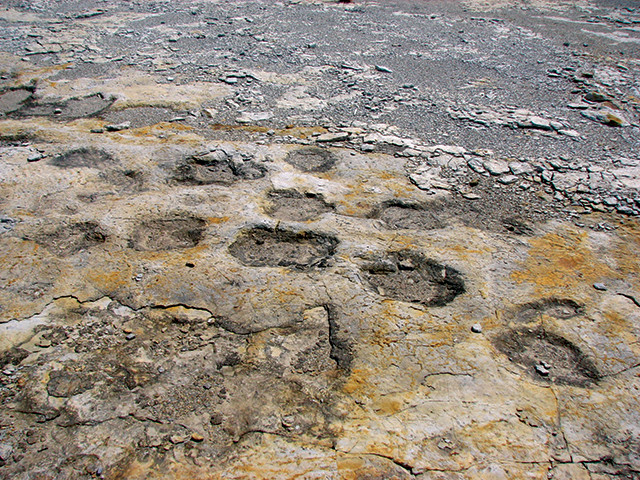
Near the Dinosaur Freeway's southern end, another spectacular tracksite was uncovered by a flood in New Mexico's Clayton Lake State Park. Credit: Terri Cook and Lon Abbott.
Beginning at the Dinosaur Discovery Center on the ridge’s western side, visitors can first view the older Morrison Formation. At the first stop, once you attune your eye, it’s easy to spot dozens of smooth, dark-brown dinosaur bones still encased in blocks of the buff-colored sandstone. The jumble of ribs, vertebrae, leg bones and other fragments from a variety of dinosaurs is typical of Morrison fossil finds.
Geologists who have studied the site believe this is because these dinosaurs died along the banks of one of the sluggish Morrison rivers, possibly after being attacked by carnivores. After scavengers picked apart the bones, a flood carried them downstream, further muddling the remains. When water currents slowed, the bones settled to the sandy river bottom, where they were encased in sandstone. It is very difficult to assemble anatomically correct skeletons from such a hodgepodge. Marsh, for example, placed the wrong skull on an apatosaur torso, an error that wasn’t corrected for more than a century. To have confidence in such reconstructions, it’s invaluable, although exceedingly rare, to find intact skeletons.
Dinosaur bones like these provide crucial information about these creatures’ anatomy, but they don’t give us any indication about how quickly a dinosaur could run, or in which direction it might have been headed. Tracks are necessary to provide this complementary information. This becomes evident at Dinosaur Ridge’s second stop, where several impressive bulges — tracks viewed in cross section rather than from above or below — graphically illustrate how large the 30-ton sauropods were that made them.
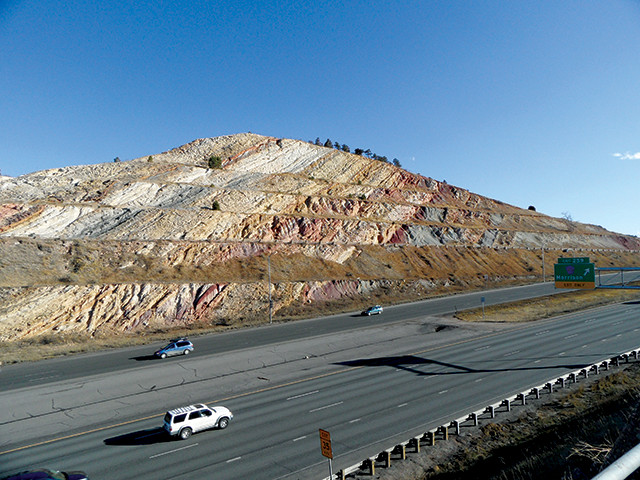
The 105-million-year-old sandstone and mudstone of the Dakota Group were deposited in a coastal setting. Credit: Terri Cook and Lon Abbott.
Near the ridge crest, the terrain crosses from the Morrison into the Dakota Group, the main unit along the ridge’s eastern side. A few kilometers farther east, these same rocks are buried several kilometers below the surface, deep enough for organic material in the formation’s carbon-rich mudstones to have been converted into natural gas and oil. More than 800 million barrels of oil and 1.2 trillion cubic feet of natural gas have been extracted from the Dakota and other Cretaceous-aged rocks in the Denver area, making it one of America’s largest petroleum fields.
As you descend the ridge’s eastern side, you’ll pass spectacular ripples as well as a sandstone bed with impressions of several mangrove logs, important clues to the rock’s former incarnation as a sandy shore on the edge of the Western Interior Seaway. The main attraction, however, is an amazing set of dinosaur tracks just uphill of the so-called “mangrove swamp.”
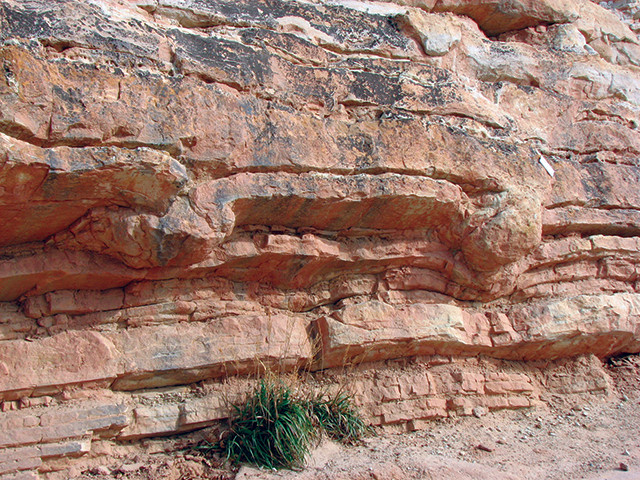
On Dinosaur Ridge's western side, huge bulges — tracks viewed in cross section — show how enormous the 30-ton sauropods were who stepped in this sand 150 million years ago. Credit: Terri Cook and Lon Abbott.
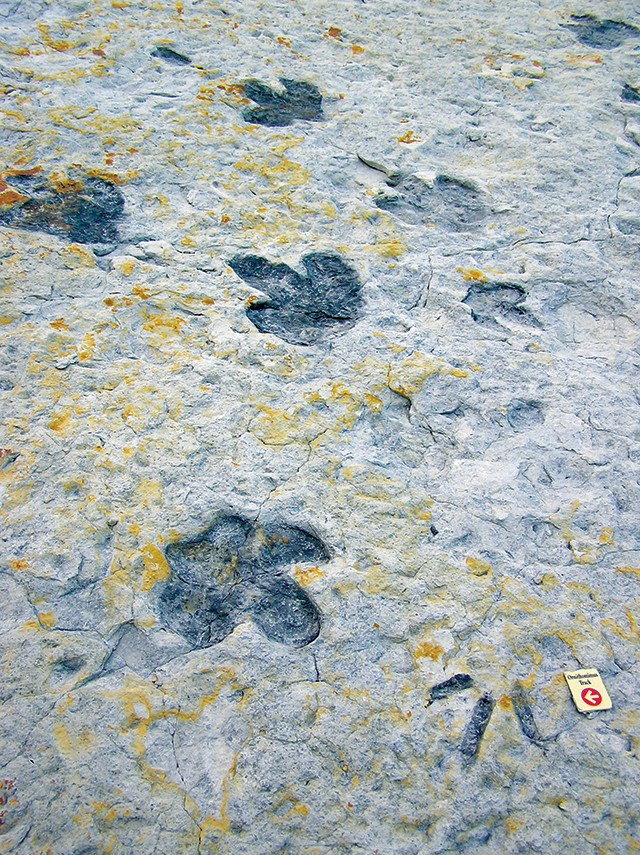
The highlight of a visit to Dinosaur Ridge is seeing the enormous sandstone slab crisscrossed with 37 different dinosaur trackways. Credit: Terri Cook and Lon Abbott.
Here, a huge sandstone slab is crisscrossed with more than 330 dinosaur prints comprising 37 different trackways. A trackway is a series of prints made by an individual dinosaur. Two different types of tracks are readily evident: A sharp, birdlike, three-toed print belonging to an ostrich-sized carnivore like Ornithomimus, and a more bulbous, hoof-like print made by an herbivorous duck-billed dinosaur such as an Iguanodon. Crocodile and bird tracks have been documented elsewhere on the ridge, as have rare two-toed raptor tracks, made by a carnivorous dinosaur like Velociraptor, which were just announced earlier this year. The tracks reveal important information that can’t be gleaned from the bones, such as the two alternating print sizes made by the smaller front and larger hind feet of a duck-billed dinosaur, depicted in many books as walking on only two legs, when in fact it often walked on all four.
Detailed studies of the Dinosaur Ridge trackways led by Martin Lockley, a dinosaur track expert at the University of Colorado at Denver, have documented that subsets of the duck-billed dinosaur tracks are oriented in different directions. Six trackways, all consisting of smaller prints, head southeast, whereas the trackways with larger prints run perpendicular to that direction. These findings indicate that the herbivores traveled in herds with other duck-bills of either the same sex or age. Based on the track spacing, the herbivores were lumbering at a leisurely pace of about 3 kilometers per hour. By contrast, the dozen Ornithomimus-like trackways show that these predators were solitary creatures that were moving about 8 kilometers per hour — about the pace of a slow jog for humans — when they sauntered through here.
Dinosaur trackways like these have been discovered at more than 120 sites in the region. They are so common in the units near the top of the Dakota Group that Lockley and other scientists have traced individual track-bearing layers nearly 700 kilometers along the Rocky Mountain Front from Boulder, Colo., to as far south as Tucumcari, N.M. Due to the widespread abundance of tracks along hundreds of kilometers of ancient coastline, paleontologists have dubbed this megatracksite the “Dinosaur Freeway,” and some have proposed that herds of dinosaurs migrated along the shore of the Western In"erior Seaway.
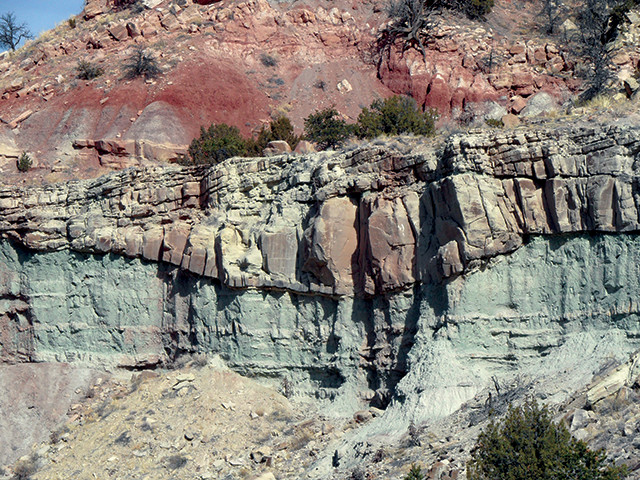
Dinosaur bones in the 150-million-year-old Morrison Formation are concentrated in lenses of sandstone surrounded by soft red, green and purple mudstones. Credit: Terri Cook and Lon Abbott.
Although the locations of many of the trackways are kept secret in order to protect them, you can visit a second freeway site at Roxborough State Park, 35 kilometers south of Denver, where a team of researchers led by Lockley discovered a large number of new tracks a few years ago. The finds include many more three-toed ornithopod tracks, as well as several from a large theropod dinosaur (the group to which Tyrannosaurus rex belongs), birds, and even parallel scratches interpreted to be crocodilian “swim tracks.”
In northeastern New Mexico’s Clayton Lake State Park, near the Dinosaur Freeway’s southern end, you can visit another spectacular tracksite with more than 500 tracks fortuitously uncovered by a flood. If you visit, be sure to look for the so-called “Dinosaur Shuffle,” a set of tracks that show a dinosaur stepping forward, and then back, several times.
While you’re in the Denver area, be sure to save some time to visit several of the region’s other “dino-mite” attractions. These include the Prehistoric Journey exhibit at the Denver Museum of Nature and Science, where you can see a reconstructed Stegosaurus battling an Allosaurus, as well as a 25-meter-long Diplodocus. The Morrison Natural History Museum houses fossil discoveries from Dinosaur Ridge and other locations. In nearby Golden, you can follow the short, flat Triceratops Trail to visit the first tracks ever discovered from this famous three-horned dinosaur and see impressions of palm fronds and other semi-tropical plants that grew in the Denver area about 68 million years ago. At the adjacent Fossil Trace Golf Club, you can putt next to Triceratops and duck-billed hadrosaur tracks and, in the clubhouse, view the cast of a Triceratops skull as well as some early mammal tracks.
About two hours southwest of Denver is another site worth visiting: Garden Park Fossil Area, near Cañon City, which is best known for the discovery of three nearly complete, school bus-sized Stegosaurus skeletons. One of the most important locations for the study of Late Jurassic dinosaurs in the U.S. and the source of numerous museum specimens, Garden Park has yielded fossil discoveries for nearly 140 years, including many from the quarries financed by Cope and Marsh during the Bone Wars. These include the first complete Allosaurus skeleton and the first-known fossils of several other Late Jurassic species, including Ceratosaurus and Camarasaurus.
Cañon City is also home to the Royal Gorge Regional Museum and History Center, which hosts a “Dinosaur Migration” exhibit featuring a cast of the world’s most complete Stegosaurus skeleton. You can also obtain information at the museum about Skyline Drive, a scenic drive along a narrow ridge just northwest of town. Like at Dinosaur Ridge, the west side is composed of the Morrison Formation, whereas the crest and eastern side are formed by the younger, more resistant Dakota Group rocks, which host more than 50 blob-like footprints. Four protrusions marking the toes in these trackways provide evidence that these bulges were made by a group of ankylosaurs, the low, club-tailed dinosaurs that look a bit like large armadillos.
These tracks, which compose the largest ankylosaur tracksite in the western U.S., were only discovered in 1999. The long and ongoing history of discovery, and the density and diversity of dinosaur sites, highlight just how important the Denver area is for learning more about these remarkable reptiles.
© 2008-2021. All rights reserved. Any copying, redistribution or retransmission of any of the contents of this service without the expressed written permission of the American Geosciences Institute is expressly prohibited. Click here for all copyright requests.